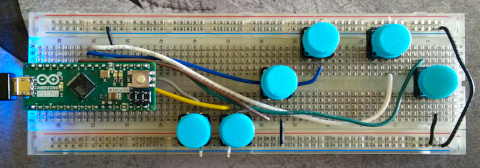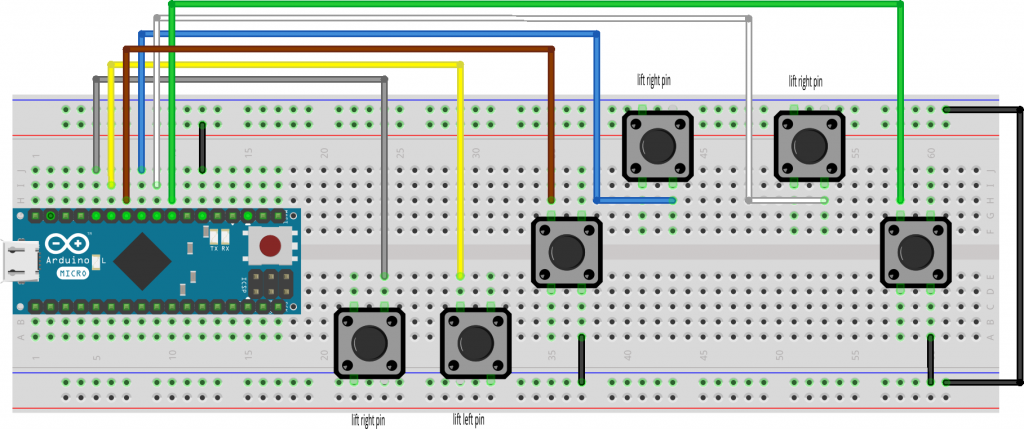
This may not look much, but it’s a test build of Vik Olliver’s Quirkey USB chord keyboard. I didn’t quite build it to Vik’s specs, which are here:
- code: VikOlliver/Microwriter: A reboot of the 80’s Microwriter accessible chord keyboard done using an Arduino
- case: Quirkey Chord Keyboard Shell
The Microwriter was a late 1970s/early 1980s gadget that was essentially a portable word processor. Unusually, its keyboard was a single-hand 6 key layout — the thumb did double duty — that was operated by chording multiple keys at the same time. Later on in the Microwriter’s life it evolved into the Quinkey, a chording adaptive keyboard for computers of the time.
Technology has moved on a bit, and the ability to wire up a cheap USB-capable microcontroller and 3d print your own case is here. I used an Arduino Micro on a breadboard and six Omron momentary buttons.
I didn’t quite wire it the way that Vik intended:

The buttons are wired like this:
Pin Button
======= =======
D8 Control
D7 Thumb
D6 Index
D5 Middle
D4 Ring
D3 Pinkie
This requires changing line 22 of Vik’s code from:
const int keyPorts[] = {8, 7, 6, 5, 4, 9};
to
const int keyPorts[] = {8, 3, 4, 5, 6, 7};
While there are great tutorials on “microwriting” in the original manuals on Bill Buxton’s site, here are the basic alphabetic set derived from Vik’s code:
Thumb
|Index
||Middle
|||Ring
||||Pinkie
â—â—‹â—‹â—‹â—‹ : Space
â—‹â—â—‹â—‹â—‹ : e
â—â—â—‹â—‹â—‹ : i
â—‹â—‹â—â—‹â—‹ : o
â—â—‹â—â—‹â—‹ : c
â—‹â—â—â—‹â—‹ : a
â—â—â—â—‹â—‹ : d
â—‹â—‹â—‹â—â—‹ : s
â—â—‹â—‹â—â—‹ : k
â—‹â—â—‹â—â—‹ : t
â—â—â—‹â—â—‹ : r
â—‹â—‹â—â—â—‹ : n
â—â—‹â—â—â—‹ : y
â—‹â—â—â—â—‹ : .
â—â—â—â—â—‹ : f
â—‹â—‹â—‹â—‹â— : u
â—â—‹â—‹â—‹â— : h
â—‹â—â—‹â—‹â— : v
â—â—â—‹â—‹â— : l
â—‹â—‹â—â—‹â— : q
â—â—‹â—â—‹â— : z
â—‹â—â—â—‹â— : -
â—â—â—â—‹â— : '
â—‹â—‹â—‹â—â— : g
â—â—‹â—‹â—â— : j
â—‹â—â—‹â—â— : ,
â—â—â—‹â—â— : w
â—‹â—‹â—â—â— : b
â—â—‹â—â—â— : x
â—‹â—â—â—â— : m
â—â—â—â—â— : p
The astute reader may note that these are binary values (low bit to high) of the character positions in Vik’s alphaTable variable. And yes, that’s supposed to be preformatted text.
Happy microwriting!